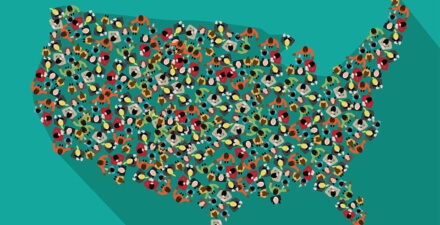Diversity in economics and data disaggregation can improve our understanding of the U.S. economy

Economics as a field is beleaguered by a diversity problem. This is not a new phenomenon, but diversity-related issues are now more widely discussed within many organizations and professional disciplines, including among economists, in light of how COVID-19 and the unraveling of the U.S. economy exposed sustained racial and social inequities alongside ongoing systemic discrimination and violence against Black Americans and other Americans of color.
The lack of representation in economics results in pervasive barriers and blind spots along the economics pipeline and pathways, from who becomes an economist and how economics is taught to how data are collected and the ways in which researchers and policymakers analyze and use those data. As a Latina economist who has long worked to diversify the profession—particularly with respect to race, ethnicity, and gender—I know all too well the obstacles that my peers face in the field, as well as the benefits of the diversity in lived experiences, viewpoints, and backgrounds that we bring to the table.
These challenges and their effects on the economics profession were largely what pushed my colleagues and me, back in 2002, to found the American Society of Hispanic Economists, a professional association of economists concerned by the underrepresentation of Hispanic voices in economics. We seek to promote research on economic and policy issues affecting Hispanic communities and the United States as a whole, and to encourage more Hispanic Americans to enter the economics profession.
I recently spoke about my experience founding ASHE and my desire to promote more diversity in economics at an Equitable Growth virtual event co-hosted by the Groundwork Collaborative earlier this year. I explained the importance of diversity of perspectives in academia to shape what we study and how we go about it. I also highlighted ASHE’s work—along with the American Economic Association’s mentoring program, which is funded by the National Science Foundation, for traditionally underrepresented minorities—in mentoring early-career economists and graduate students.
These young scholars tend to be more at-risk of leaving the economics profession—or even not entering it at all or completing their degrees—due to harassment, discrimination, feelings of isolation, or unfair treatment arising from lack of diversity. (See video for details.)
The event centered on the importance of racial equity in federal data collection and how disaggregating data can illuminate certain racial and ethnic inequalities that permeate our economy and society. Better understanding the lived experiences of various demographic groups expands our understanding of how the economy is working for all Americans in a way that is often obscured by more traditional macroeconomic aggregate numbers, such as Gross Domestic Product. And disaggregated data can guide policymakers as they work to address racial disparities and the systemic racism from which they stem.
The push to disaggregate data along race and ethnicity lines is one I have long worked on and am passionate about, particularly as it relates to specific subgroups of the Hispanic American community. The experiences of Mexican Americans or Puerto Ricans differ from those of Cuban Americans or Dominicans, for instance, but those distinctions are obscured by aggregate statistics that lump all Hispanics together.
There also are differences within subgroups. Mexican Americans, for example, include immigrants from Mexico but also U.S. natives whose families have lived in areas that predate the United States. And Puerto Ricans growing up in Puerto Rico are U.S. citizens by birthright, but their lived experiences are not necessarily the same as those growing up on the U.S. mainland.
As I mentioned at the Equitable Growth-Groundwork Collaborative event, “When we think about the Hispanic or Latino population, it’s actually quite heterogeneous. And sometimes … we just hear about the ‘Hispanic population’ or what’s happening with Hispanic employment or unemployment, without understanding that there are key differences within the Hispanic population.” (See video for details.)
So, what can academics and policymakers do about it?
For one, oversampling would improve the ability to analyze subgroups of the U.S. population. Oversampling is a survey tool that targets specific groups at a higher rate than they appear in the overall population to address the frequent underrepresentation of these groups in surveys. Larger samples would help researchers uncover different economic and social experiences of these communities and facilitate disaggregation among subgroups that are not well-represented by the aggregate data.
For instance, I often use the U.S. Census Bureau’s American Community Survey in my research because it is a large dataset that allows for some disaggregation of Hispanic groups. But even the ACS is limited in its ability to break down certain smaller subpopulations, and this is where expanding sample sizes could be useful.
In addition to oversampling, it is essential to complement survey and administrative data with on-the-ground data so that policymakers can develop and implement more effective policies to address specific needs of target groups. When I served on the board of directors of the Federal Reserve Bank of Dallas’ San Antonio branch, I quickly understood the value of having researchers and other stakeholders in the community learn firsthand about local conditions and gather so-called economic intelligence from the areas we, as board members, represented.
Indeed, the conversations we had in our respective communities shaped our understanding of the lived experiences of local residents and allowed us to examine, almost in real time, the potential effects of policies under consideration by the Fed. By sharing our insights with the Fed, we were able to help it formulate and implement more effective monetary policy.
In other words, collecting more and better data allows for more and better data disaggregation and analysis, which, in turn, allows for better policy decisions and outcomes. Knowing how to collect these data begins with empowering economists from diverse backgrounds to shape how we study different groups of people while providing unique perspectives from our lived experiences, making sure all voices are heard and respected.
As I and my fellow panelists reiterated, while disaggregating the data we collect and having “boots on the ground” requires effort and resources, not taking these steps is doing a disservice to ourselves, our research, the communities we study, and to local and national economic prosperity.
—Marie T. Mora is associate vice chancellor for strategic initiatives and professor at the University of Missouri-St. Louis.





